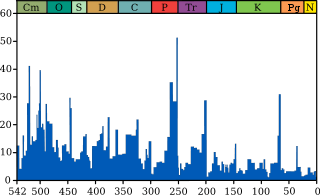Cambrian–Ordovician extinction event
The Cambrian–Ordovician extinction event occurred approximately 488 million years ago (m.y.a.). This early Phanerozoic Eon extinction event eliminated many brachiopods and conodonts, and severely reduced the number of trilobite species.
It was preceded by the less-documented (but probably worse) End-Botomian extinction event around 517 million years ago and the Dresbachian extinction event about 502 million years ago.
The Cambrian–Ordovician event ended the Cambrian Period, and led into the Ordovician Period in the Paleozoic Era.
Theories
- Glaciation
- Depletion of oxygen in marine waters
- Flood basalt event (Kalkarindji large igneous province, Australia) [1]
See also
- End-Botomian extinction event, circa 517 m.y.a.
- Dresbachian extinction event, circa 502 m.y.a.
- Geologic time scale
- Furongian, Late or Upper Cambrian period
- Early Ordovician period
Further reading
- Gradstein, Felix, James Ogg, and Alan Smith, eds., 2004. A Geologic Time Scale 2004 (Cambridge University Press).
- Hallam, Anthony and Paul B. Wignall, 1997. Mass extinctions and their aftermath (Oxford University Press).
- Webby, Barry D. and Mary L. Droser, eds., 2004. The Great Ordovician Biodiversification Event (Columbia University Press).
References
- ↑ Kravchinsky, V. A. (2012). Paleozoic large igneous provinces of Northern Eurasia: Correlation with mass extinction events. Global and Planetary Change, 86, 31-36.
External links
| Extinction events |
|---|
|
Minor events Major events │ −600 │ −550 │ −500 │ −450 │ −400 │ −350 │ −300 │ −250 │ −200 │ −150 │ −100 │ −50 │ 0 Millions of years before present |
This article is issued from
Wikipedia.
The text is licensed under Creative Commons - Attribution - Sharealike.
Additional terms may apply for the media files.
